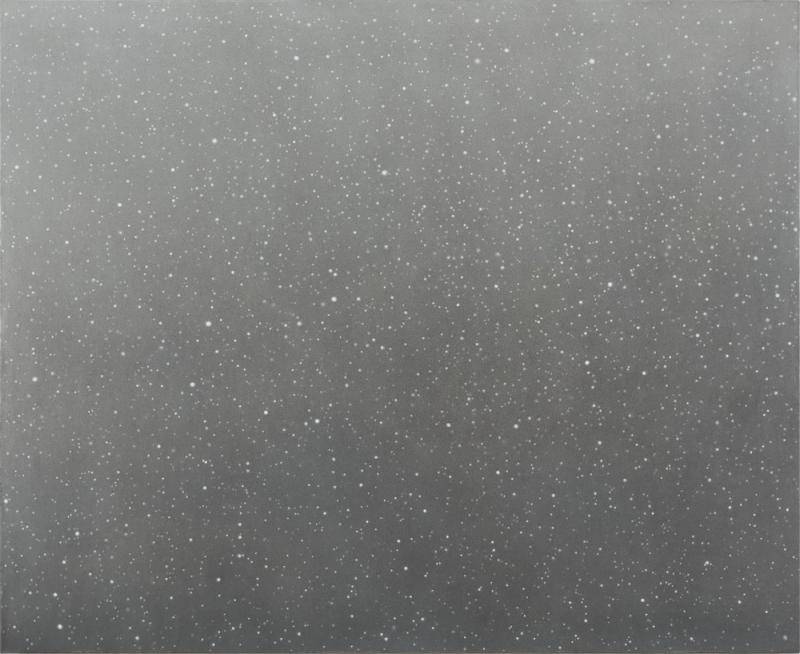Skip to main content
Night Sky #17
Artist
Vija Celmins
(American, born 1938)
Date2000-01
MediumOil on linen, mounted on wood
DimensionsUnframed: 31 × 38 in. (78.74 × 96.52 cm)
Credit LineCollection of the Modern Art Museum of Fort Worth, Gift of The Burnett Foundation
Object number2002.3
Status
Not on viewCopyright© Vija Celmins. Courtesy Matthew Marks Gallery.
Category
Label TextVija Celmins’s small-scale, mostly monochrome images have made a quiet but formidable contribution to American art since the 1960s. She is known for her meticulous paintings, drawings, and prints of objects and boundless environments such as starry skies, ocean surfaces, and desert floors. Working from photographs, taken herself or appropriated from other publications, the artist laboriously transposes one surface to another, photographic image to drawn or painted one.
Celmins studied painting in graduate school at the University of California, Los Angeles, beginning in 1962. The debut that year of Andy Warhol’s paintings of Campbell’s soup cans at LA’s Ferus Gallery, alongside important exhibitions like Six Painters and the Object at the Los Angeles County Museum of Art, introduced a new generation of California painters to Pop art. Artists including Ed Ruscha and Larry Bell adopted the themes of mass media and advertising from their New York counterparts but with a cool detachment and precision that came to characterize the unique aesthetics of West Coast Pop. Within this “Cool LA” scene, Celmins developed an intimate realist language of her own to reflect the world around her.
In 1981, Celmins moved to New York and began an extended series focused on the night sky, which marked her return to painting after a period devoted to drawing. These works derive from satellite images in astronomy publications. Night Sky #17, 2000–01, is an exemplary painting from this body of work and depicts a sky glittering with seemingly infinite stars. To achieve a smooth surface, the artist built up layers of gesso, then sanded to eliminate the texture of canvas. Over many weeks, she dabbed minute touches of white onto a gray background, suffusing the dark field with shimmering flecks of light. In every work, Celmins builds up her images slowly and meditatively, through innumerable, patient, small touches. In the same way, to contemplate the depth and nuance of Night Sky #17 requires us to slow down our vision as we allow our eyes to adjust to the work’s inner light.
Celmins studied painting in graduate school at the University of California, Los Angeles, beginning in 1962. The debut that year of Andy Warhol’s paintings of Campbell’s soup cans at LA’s Ferus Gallery, alongside important exhibitions like Six Painters and the Object at the Los Angeles County Museum of Art, introduced a new generation of California painters to Pop art. Artists including Ed Ruscha and Larry Bell adopted the themes of mass media and advertising from their New York counterparts but with a cool detachment and precision that came to characterize the unique aesthetics of West Coast Pop. Within this “Cool LA” scene, Celmins developed an intimate realist language of her own to reflect the world around her.
In 1981, Celmins moved to New York and began an extended series focused on the night sky, which marked her return to painting after a period devoted to drawing. These works derive from satellite images in astronomy publications. Night Sky #17, 2000–01, is an exemplary painting from this body of work and depicts a sky glittering with seemingly infinite stars. To achieve a smooth surface, the artist built up layers of gesso, then sanded to eliminate the texture of canvas. Over many weeks, she dabbed minute touches of white onto a gray background, suffusing the dark field with shimmering flecks of light. In every work, Celmins builds up her images slowly and meditatively, through innumerable, patient, small touches. In the same way, to contemplate the depth and nuance of Night Sky #17 requires us to slow down our vision as we allow our eyes to adjust to the work’s inner light.










